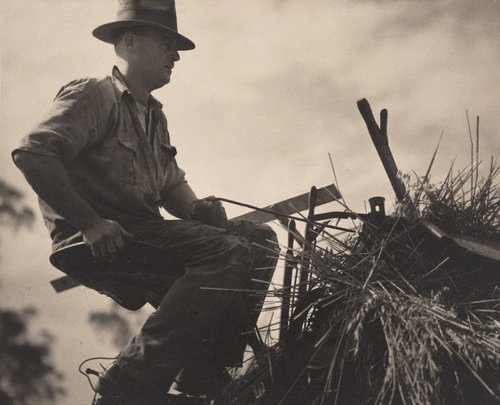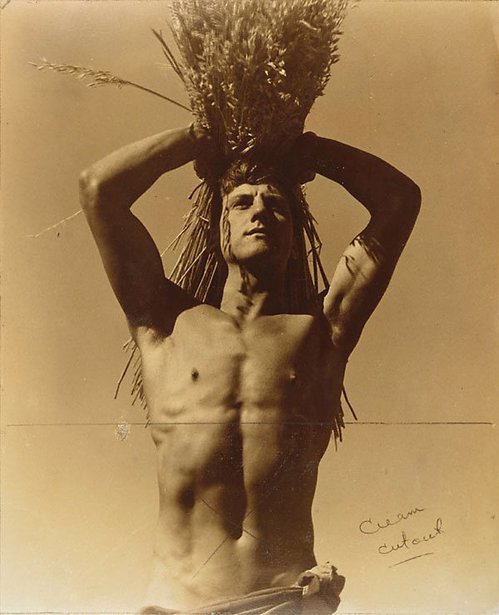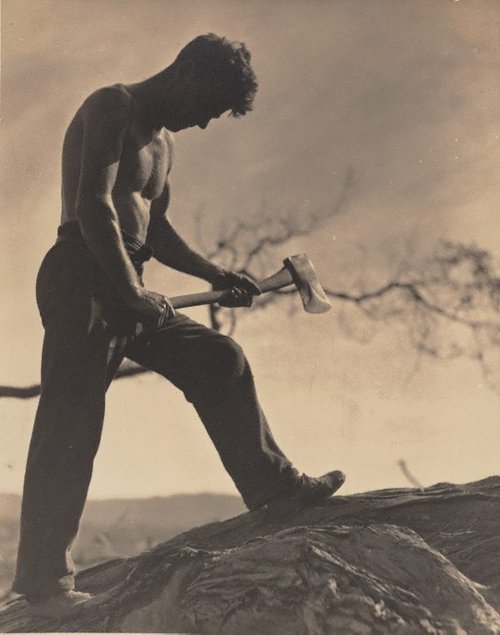-
Details
- Date
- circa 1940
- Media category
- Photograph
- Materials used
- gelatin silver photograph, vintage
- Dimensions
- 30.5 x 35.5 cm image/sheet
- Signature & date
Signed l.r. original mount, pencil "Keast Burke". Not dated.
- Credit
- Gift of Iris Burke 1989
- Location
- Not on display
- Accession number
- 95.1996
- Copyright
- Artist information
-
Keast Burke
Works in the collection
- Share
-
-
About
‘Husbandry 1’ is from the portfolio of male figure studies that won Keast Burke associate membership of the Royal Photographic Society in 1941.1 Burke had begun working with the male figure around 1938 inspired by his interest in classical literature and art which had blossomed when he was in the Middle East with the Australian Imperial Force from 1917 to 1919. Burke wanted to show the nature of man as being active and so he took a substantial number of photographs where the model is associated with sport (javelin, discus) and with trades of various sorts (building, sailing, farming). The model for ‘Husbandry 1’ was his wife’s brother. Burke was as influenced by the times in which he lived as Dupain and so one can read not dissimilar notions into his photographs: the sense of impending war and the necessity for bodily strength, vitalism and neo-paganism.
‘Husbandry 1’ depicts the nude male as young, strong and vital. The figure against the flat sky is monumental, having been shot from slightly below. The steady gaze into the sun and sombre expression, the muscular arms holding what appears to be fruit from the ‘Jelly Palm’,2 exhibits readiness and fitness. The straw hat is a similar shape to a soldier’s helmet so that the image presents a web of contemporary ideas to do with activity, supremacy, beauty, masculinity, classicism and the corresponding loss of these. As Isobel Crombie has pointed out, the tanned body and the emphasis on the life-giving force of the sun, which is clearly an important aspect of this photograph, was common in such images. Diseases such as tuberculosis and rickets were a scourge between the wars and exposure to sunshine, as well as nudity, was considered to be an important part of a cure.3
1. ‘Australian Dictionary of Biography’, vol 13, 1940–80, Melbourne University Press, Melbourne p 303 states that Burke was elected to the ARPS in 1938, however the family are categorical that it was October 1941
2. The ‘Jelly Palm’ (‘Butia capitata’) originates in Brazil but is widely grown in Australia for its ornamental qualities and delicious fruit. Burke mentions in ‘Australasian Photo-Review’, May 1941 p 160, that he used Kentia palm seeds but the Royal Botanical Gardens, Sydney, are certain that the fruit in ‘Husbandry 1’ is not from the Kentia Palm
3. Crombie I 2004, ‘Body culture: Max Dupain, photography and Australian culture, 1919–1939’, Peleus Press/National Gallery of Victoria, Melbourne p 149© Art Gallery of New South Wales Photography Collection Handbook, 2007
-
Exhibition history
Shown in 3 exhibitions
The Image of Man: Photography and Masculinity 1920 to 1950, Art Gallery of New South Wales, Sydney, 07 Feb 1997–06 Apr 1997
The photograph and Australia, Art Gallery of New South Wales, Sydney, 21 Mar 2015–08 Jun 2015
Brave New World; Australia 1930s, National Gallery of Victoria [St Kilda Road], Melbourne, 14 Jul 2017–15 Oct 2017
-
Bibliography
Referenced in 6 publications
-
Judy Annear, Photography: Art Gallery of New South Wales Collection, 'Australian modernism', pg.131-149, Sydney, 2007, 133 (illus.), 143 (illus.).
-
Judy Annear and Daniel Mudie Cunningham, The Image of Man, Sydney, 1997. no catalogue numbers
-
Judy Annear, The photograph and Australia, Sydney, Jun 2015, 103 (colour illus.).
-
David Meagher, Capital Q Weekly, 'Men, Myth & Masculinity', pg. 4, Sydney, 31 Jan 1997, 4 (illus.).
-
Wendy Symonds (Editor), Look, 'The Image of Man Photography and Masculinity 1920-1950', pg. 11, Heidelberg, Feb 1997, 3 (illus.), 11 (illus.).
-
Peter Timms (Editor), Art Monthly Australia, Canberra, Mar 1997, cover (illus.).
-




